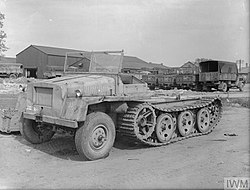| Schwerer Wehrmachtschlepper | |
|---|---|
 | |
| Type | Half-track |
| Place of origin | Nazi Germany |
| Service history | |
| In service | 1944—1945 |
| Used by | Nazi Germany |
| Wars | World War II |
| Production history | |
| Designer | Büssing-NAG |
| Designed | 1942—1943 |
| Manufacturer | Büssing-NAG, Tatra |
| Produced | 1943—1945 |
| No. built | 825 |
| Variants | 15 cm Panzerwerfer auf sWS 3.7cm FlaK 43 auf sWS |
| Specifications | |
| Mass | 13.5 tonnes (14.9 short tons; 13.3 long tons) |
| Length | 6.92 m (22 ft 8 in) |
| Width | 2.5 m (8 ft 2 in) |
| Height | 2.07 m (6 ft 9 in) |
| Crew | 2 |
| Armor | 6-15 mm (certain models only) |
| Engine | 4.198 L (256.2 cu in) gasoline inline 6 cylinder, water-cooled Maybach HL42 TRKMS 100 hp (75 kW) |
| Payload capacity | 4,000 kg (8,800 lb) |
| Transmission | ZF kb 40D |
| Suspension | transverse leaf-spring and torsion bar |
| Ground clearance | 46.5 cm (18.3 in) |
| Fuel capacity | 240 L (53 imp gal; 63 US gal) |
Operational range | 300 km (190 mi) |
| Maximum speed | 27.4 km/h (17.0 mph) |
The Schwerer Wehrmachtschlepper (sWS; "Heavy Military Tractor") was a German World War II half-track vehicle used in various roles between 1943 and 1945. The unarmored models were used as supply vehicles and as tractors to haul artillery. Armored versions mounted anti-aircraft guns or a 10 barrel rocket launcher ( Nebelwerfer ). Fewer than a thousand were built before the end of the war, but production continued after the war of an improved model in the Tatra plant in Czechoslovakia.
